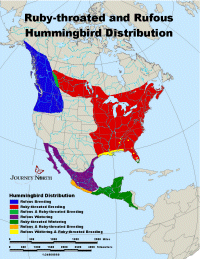Today's Report Includes:
- The
Migration: Highlights,
Maps, and
Questions
-
Journal:
Why Are
Rufous Hummers Far Ahead?
- Slideshow:
An
Amazing Rubythroat Journey!
- Questions?
Ask the Expert
Opens March 14
Your Sightings! >>
 Distribution Map |
||
| Rufous
|
Ruby-throated
|
|
| Handouts:
Today's Hummingbird Map Questions Rufous Questions > Rubythroat Questions > |
||
|
Highlights:
Welcoming the Waves |
How can rufous hummingbirds be in Canada already, when rubythroats are still gathered in the southern United States? Are the Rufous hummers faster or more eager? Is this just an unusual year?
Think:
Write your ideas in your Hummingbird Journal >>
Discover: Watch this short slideshow! >>
As ruby-throated hummingbirds enter the United States from their wintering grounds, many hit Louisiana (and nearby Gulf states) first. How do you think they get there? Do they brave the open water or fly over land? Tell us what you think!
-
Handout: How Do Ruby-throated Hummingbirds Get Here? >>
- Slideshow: An Amazing Rubythroat Journey >>
Journey North's hummingbird expert (and bander) Lanny Chambers has again volunteered to answer your questions.
Lanny has had a life-long passion for hummingbirds. He researches them and runs an award-winning Web site about their migrations. Here is your chance to ask Lanny questions you haven't been able to answer yourselves.
- Meet Lanny and submit your questions on the Web >>
- The deadline for questions is Friday, March 28 (1 pm EDT).
- Teachers: Getting Started with the Hummingbird Migration >>
- Predict: Where Will They Arrive, and When? Making Predictions >>
- Explore: Ladies Second: Why Male Hummingbirds Lead the Migration >>
- Slideshow: An Amazing Rubythroat Journey >>
- Lesson: When Will Our Hummingbird Habitat Be Ready? >>
- Hummingbird Migration Journals (click-and-print) >>
- Hummingbirds for Kids (booklets, photos, videos) >>
The Next Hummingbird Migration Update Will Be Posted on March 20, 2008.








